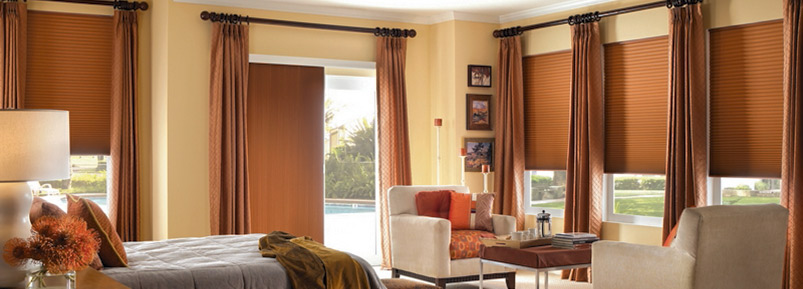
Next to a new coat of paint, window treatments make the most impact in a room makeover. Choosing the type of window covering is a balancing act between practical and aesthetic needs for a particular room. Here we consider the factors involved in choosing blinds or shades. Either of these choices can be teamed with drapery as curtains or valances to achieve the look you want.
Blinds and shutters are “hard window treatments” made with wood, composite, vinyl or aluminum slats. These window treatments can be partially or completely opened by rotating the slats. Shades are “soft window treatments” made of vinyl, fabric, or woven woods or grasses. Shades are generally opened by rolling or folding from the bottom by means of a roller or pulley mechanism.
If you are trying to decide which window covering is right for you, consider the following factors:
View
Choose blinds or shutters with larger slats so that more of that great view can be seen when they are open. If you choose shades, then you’ll want shades that retract fully into the headrail.
Window Size & Shape
Consider blinds or shutters for specialized architectural windows like a bay window or special shaped windows. Choose vertical slats only if your window is wider than it is tall.
Decor
Shutters and blinds are well suited to contemporary or masculine interiors. Curtains and shades are better for feminine rooms. Consider the mix of materials in the room to help balance the decor. A wood blind might complement a room that is filled with soft, feminine details. Blinds, shutters and shades come in a variety of materials and colors suitable for any use.
Use of the Room
Consider the activities that take place in the room. Will you need flexible lighting? Is privacy important? The material that shades are made of can go along way toward light control. They come in materials that range from black out to shear. Black out shades have a special coating that blocks 99% of light. Blinds are perhaps more flexible in controlling light. They can be completely or partially opened to provide just what is needed based on environmental lighting.
Climate
Window coverings can actually help with energy efficiency. Pay attention to the R-value of your choices. Shades with a value of 4 or more are considered energy efficient. Rooms that get direct sunlight at any time of day can benefit from cellular shades that trap hot or cold air at the window surface. Some honeycomb shades have a R-value of more than 7. Consider the movement of the sun throughout the day/season and the direction the window faces when choosing window treatments. Balance the radiant energy needs with the fact that UV radiation can be damaging to furniture and flooring.
Maintenance & Life
Blinds and shutters require an occasional dusting and are easier to clean than shades. Blinds may be a problem in homes of people with allergies to dust since dirt tends to accumulate on the slats. Weekly attention with a feather duster is an easier option than wiping each slat. Shades can stain and they do wear out faster than blinds or shutters. In fact, the industry standard for the life of a blind is 3 to 5 years. Shutters can last a lifetime.
Let Us Help You
Have additional questions? Want to know which manufacturer will best meet your needs? Just need an experienced designer to bounce around ideas with? Rainbow Paint & Decorating has 38 years of experience helping clients create beautiful interior spaces. Contact our in-house designer for an appointment or stop by our Greystone or Vestavia Hills location for a free consultation.
